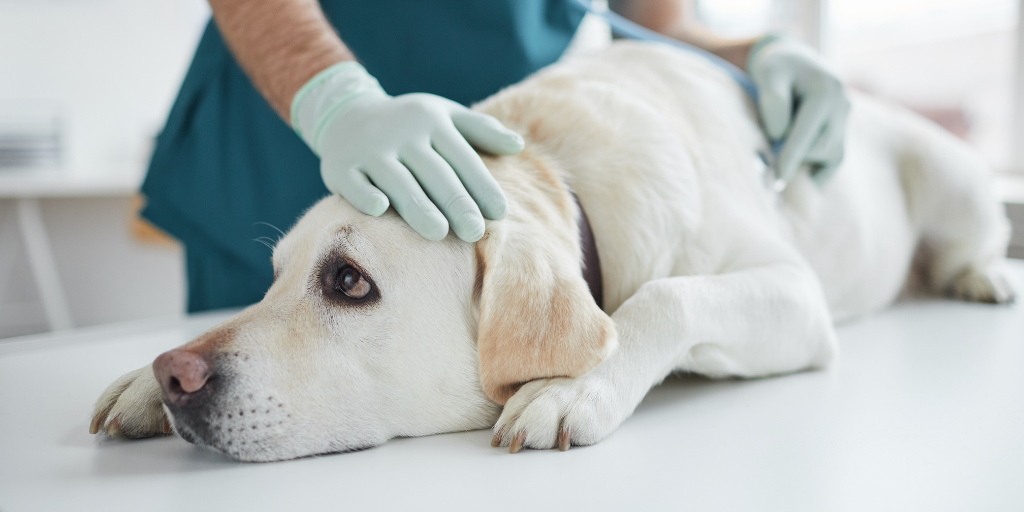Chronic kidney disease (CKD) is one of the more common conditions that affects dogs and one of the leading causes of death in pets. In fact, up to 10% of older dogs are diagnosed with the disease, according to Michigan State University Vet Diagnostic Lab. Our dog Brody was diagnosed with CKD, which was quite the gut punch since it is progressive and irreversible. But we pulled ourselves together and educated ourselves on what to do to prolong our good boy's life. Here are 12 questions answered about chronic kidney disease in dogs, including what to look out for, what you can do to manage it and more.
Dog Kidney Basics: What Do Our Dog's Kidneys Do?
Dog kidneys function similarly to the human organ. Their main purpose is to remove waste from the blood, balance and regulate nutrients (like potassium and sodium), maintain hydration and produce urine. They also help control blood pressure, increase red blood cell production, and metabolize calcium.
What Exactly Is CKD?
In simple terms, CKD is the "wearing out" of the kidneys. It means that the kidneys are not working properly or efficiently to filter out waste from the blood. It does not mean your dog won't produce urine. In fact, quite the opposite is true - dogs with CKD produce a lot of urine, it just doesn't have the proper amount of waste that should be eliminated from the body.
Is CKD The Same As Renal Failure?
CKD is also called chronic renal failure, chronic kidney failure and renal insufficiency. This may cause some confusion, as the term "failure" makes it sound acute. But the reality is that because CKD is progressive and irreversible, kidney failure is the outcome, though it won't be acute.
What Causes CKD in Dogs?
The specific cause for individual dogs is usually unknown, though it is associated with aging. This is because it's a slowly progressing disease with early signs often being mild and undetectable. But there are some known causes of CKD, including:
- Dental disease (bacteria on the teeth can enter the digestive system during eating or drinking and damage kidneys over time)
- Infection
- Toxin ingestion from cleaners and disinfectants, human medications, lead, antifreeze and more
- Cancer
- Injury
While the cause is usually unknown, there are factors that can contribute to CKD or make certain dogs more prone to it. These include:
- Age
- Foods with higher protein and phosphorus
- High blood pressure
- A history of urinary issues such as kidney stones, urinary tract infections, pyelonephritis (when inflammation of urinary tract causes bacteria to go into the kidney) and glomerulonephritis (inflammation in the kidneys, the glomeruli (structures of vessels, fibers, or neurons in the organ) or blood vessels)
- Lyme disease
- Hereditary conditions such as defects in the kidneys
- Certain breeds, including:
- Bull Terrier
- Cocker Spaniel
- Doberman Pinscher
- German Shepherd
- Lhasa Apso
- Poodle
- Rottweiler
- Samoyed
- Shih Tzu
- Soft Coated Wheaten Terrier
What Are The Signs Of CKD?
The first most commonly detected signs of CKD are excessive thirst and urination. This occurs because the kidneys aren't filtering properly, so blood flow to the organ increases (since less toxins are being removed from the blood) in an attempt to increase filtration. This leads to higher urine production as well as higher water consumption to prevent dehydration. Overall, signs include:
- Increased urination (volume, frequency and dilution)
- Increased thirst and water consumption
- Loss of appetite
- Vomiting and/or nausea
- Diarrhea
- Lethargy and/or weakness
- Bad breath
- Depression or loss of interest in things (like interacting, playing, etc.)
- Weight loss
- Blood in urine
- Pale gums, ulcers in the mouth and other signs of dental disease
As the disease progresses, symptoms may worsen and include:
- High blood pressure
- Decreased urine and/or blood in urine
- Anemia
- Inability to regulate body temperature
- Stomach ulcers
- Seizures
How Is CKD Diagnosed?
CKD is diagnosed using basic lab tests to measure kidney function such as a complete urinalysis, a blood chemistry analysis, a complete blood count (for CBC) and blood electrolyte tests.
- The urinalysis will evaluate kidney function through two specific tests:
- Urine specific gravity (USpG) to measure concentration or dilution of urine. Low USpG (dilute urine) is typically the first indication of kidney disease.
- Proteinuria to measure protein in the urine. Increased protein indicates decreased kidney function.
- The blood chemistry analysis evaluates kidney function by measuring waste products in the blood, specifically blood urea nitrogen (BUN) and blood creatinine (CREA) - both of which indicate decreased kidney function. The blood test also determines the severity of CKD by measuring levels of albumin, globulin, potassium, sodium, phosphorus and calcium. Blood phosphorus levels may be higher in dogs with CKD.
- The CBC measures red and white blood cells to identify any anemia, infection or other issues.
- The blood electrolyte analysis measures the amount of electrolytes in the blood to determine if they are balanced, which is one of the functions of the kidneys.
When Is CKD Diagnosed?
When a dog is diagnosed often relates to their size in that smaller dogs tend to show signs between 10-14 years old, and larger dogs can show signs as early as seven years old. But because early CKD is hard to detect, the disease is often diagnosed when at least two thirds of the kidneys are dysfunctional. Kidneys have a large reserve to continue performing their jobs, since the tissue can't regenerate once destroyed. This is why clinical signs don't show up until much of the organs have lost function. Unfortunately, this means dogs are usually diagnosed in stage two or beyond and kidney deterioration has been occurring for months or years.
How Is The Degree Of CKD Determined?
There are four stages of CKD, with one being the least severe. Your vet will compare the lab results and blood pressure to the International Renal Interest Society (IRIS) staging system to determine the severity of CKD. The IRIS uses creatinine levels, with a sub-staging of protein levels using a urine protein to creatine ratio (UPC), to categorize the various stages of CKD:
- Stage 1 - creatinine <1.4
- Stage 2 - creatinine 1.4-2.0
- Stage 3 - creatinine 2.0-5.0
- Stage 4 - creatinine >5
- Proteinuric - UPC ratio >0.5
- Borderline proteinuric - UPC ratio 0.2-0.5
- Non-proteinuric - UPC ratio <0.2
Assessing the stage of CKD allows your vet to better tailor treatment, monitor the progression of the disease and provide an estimated prognosis.
How Is CKD Treated?
As aforementioned, CKD is progressive and irreversible. But that doesn't mean there aren't ways to manage and treat the disease to prolong your dog's life by several months or years. Exact treatment depends on the severity of the disease and what side effects your dog is experiencing. Also, it's important to note that treatment will change as the disease progresses. Various treatments include:
- Flushing the kidneys to remove toxins from the blood using intravenous (IV) fluids. The fluids must be administered at a high enough rate to flush the system, but not so high that it affects the heart.
- Repeated lab tests over several weeks or months, depending on the severity of the disease, to monitor the progression.
- Food change to a prescription therapeutic diet specifically designed and carefully balanced for CKD. These diets are not acidified and have lower protein, phosphorus, sodium and calcium to lessen stress on the kidneys.
- Increasing water intake at home to help flush toxins from the kidneys and keep your dog hydrated. It's important to provide fresh water in a clean water bowl to avoid growth of bacteria and other harmful organisms.
- At home fluid therapy, where the owner inserts a needle with a set amount of fluids under the loose skin between the shoulder blades. This may be done daily or several times a week.
- Medications to treat side effects and health issues from loss of kidney function. These can include:
- Antacids to reduce excess acid from the kidneys not regulating pH.
- Antiemetics to relieve nausea and vomiting, as well as improve appetite in some cases.
- ACE inhibitors and other blood pressure medications to control protein loss and regulate blood pressure.
- Medications that regulate the parathyroid gland and calcium levels, such as Calcitrol, for parathyroid gland issues.
- Medicine that encourages urine production.
- Medications that stimulate the bone marrow to produce new red blood cells, such as synthetic erythropoietin, for persistent anemia.
- Supplements to help pick up the slack where the kidneys no longer can. These can include:
- Phosphate binders to lower the amount of phosphorous the body absorbs. For example: Rx Vitamins For Pets Phos-Bind.
- Electrolytes to balance blood levels.
- Vet created clay that can help remove toxins from the body and bulk up loose stools. For example: Rx Vitamins For Pets Rx Clay.
- Fish oil, which has been shown to have some benefits for dogs with CKD. There are many dog fish oil options to choose from.
- Rehmannia Root, which may help support kidney function (though studies are limited). For example:
How Long Can Dogs Live With CKD?
The prognosis for dogs with CKD varies greatly, depending on the severity of the disease and your dog's response to treatment. But there are general estimates based on the stage:
- Stage 1: more than 400 days
- Stage 2: 200 to 400 days
- Stage 3: 110 to 200 days
- Stage 4: less than 110 days, with average being 14 to 80 days
Though CKD is progressive and irreversible, some dogs can live for several years thanks to treatment. Other dogs may only live for a few months, even with the proper treatment. It all depends on how far along the disease is and how your dog responds to treatment.
Can CKD Be Prevented?
Though your dog may end up with CKD anyway, there are ways to try and prevent that from happening. These include:
1. Dental Care
Maintaining good dental hygiene for your dog is important for their long term health. This is because bacteria on your dog's teeth can enter the digestive system during eating or drinking and damage kidneys over time. A few ways to provide your dog with dental care include:
- Brushing your dogs teeth regularly (recommended daily). You can use pet safe toothbrushes and toothpaste or finger brushes. Even brushing without the toothpaste is better than nothing.
- Dental chews, treats and toys to help remove plaque and other buildup. Safe chewing bones, such as bully sticks, can also be useful for this.
- Dental care additives for your dog's water, if he or she enjoys the taste.
- Regular dental cleanings at your vet.

